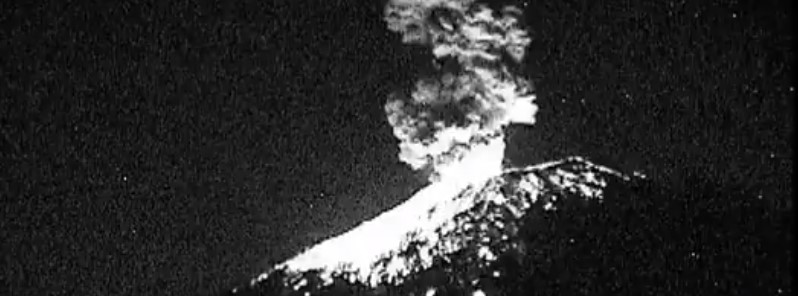New strong explosions at Popocatepetl, ash to 8.5 km (28 000 feet) a.s.l.

A new strong explosion occurred at Mexico's Popocatepetl volcano at about 04:52 UTC on Saturday, November 25, 2017 (22:52 local time, November 24). The event follows two strong explosions at 23:12 and 23:54 UTC on Friday and the strongest eruption at this volcano since 2013 at 20:13 UTC (14:13 local time) on Thursday.
Mexico's National Center for Disaster Prevention (CENAPRED) said the 04:52 UTC explosion ejected incandescent material that was deposited up to 1 km (0.62 miles) from the edge of the crater. The eruption produced a column of ash that exceeded a height of 2.5 km (8 200 feet) above the crater and drifted to the SSE. The volcanic alert level remains at Yellow.
The eruptive column reached a height of 8.5 km (28 000 feet) by 05:52 UTC, the Washingon VAAC said 06:40 UTC. "Imagery shows the new emission of volcanic ash is moving SSE at 18 – 28 km/h (11 – 17 mph)," the center said.
Ashfall was reported in the municipalities of Tianguismalanco, Atzizhuacan, and Huaquechula.

Webcams monitoring the volcano captured the following eruption at 23:12 UTC on Friday, November 24 (17:12 local time). The eruptive column reached a height of about 3 km (9 842 feet) above the crater / 8.5 km (28 000 feet) above sea level.
Actividad del Popocatépetl de lab 17:11, un poco mayor que la de ayer de las 14:13. pic.twitter.com/YRmtHezS6W
— Dr. Carlos Valdes (@CarlosMValdes1) November 24, 2017
#Exhalación del #Popocatépetl a las 17:12 horas, con una altura de 2,000 metros con contenido moderado de ceniza, dirección sureste. @webcamsdemexico pic.twitter.com/Tpp9F2IQBD
— Luis Felipe Puente (@LUISFELIPE_P) November 24, 2017
Video de actividad del Popocatépetl de las 17:12. Dirección sureste. Altura 3 Km sobre el cráter. pic.twitter.com/lny3io1Hbl
— Dr. Carlos Valdes (@CarlosMValdes1) November 24, 2017
Another similar eruption was registered at 23:54 UTC (17:54 local time):
Video 17:54 de la actividad del Popocatépetl. pic.twitter.com/gOVYTNdBVl
— Dr. Carlos Valdes (@CarlosMValdes1) November 25, 2017
Both events are visible in the video below:


The three events follow the strongest eruption at this volcano since 2013 that started at 20:13 UTC (14:13 local time) on November 23 and lasted about 90 minutes, producing a plume of ash to around 1 800 m (5 900 feet) above the crater. That's 7 226 m (23 700 feet) above sea level.
Geological summary
Volcán Popocatépetl, whose name is the Aztec word for smoking mountain, towers to 5 426 m (17 801 feet) 70 km (43.5 miles) SE of Mexico City to form North America's 2nd-highest volcano. The glacier-clad stratovolcano contains a steep-walled, 400 x 600 m (1 312 x 1 968 feet) wide crater. The generally symmetrical volcano is modified by the sharp-peaked Ventorrillo on the NW, a remnant of an earlier volcano. At least three previous major cones were destroyed by gravitational failure during the Pleistocene, producing massive debris-avalanche deposits covering broad areas to the south. The modern volcano was constructed south of the late-Pleistocene to Holocene El Fraile cone.
Three major plinian eruptions, the most recent of which took place about 800 CE, have occurred from Popocatépetl since the mid-Holocene, accompanied by pyroclastic flows and voluminous lahars that swept basins below the volcano. Frequent historical eruptions, first recorded in Aztec codices, have occurred since precolumbian time. (GVP)
Featured image: Popocatepetl eruption at 04:52 UTC on November 25, 2017. Credit: CENAPRED

Commenting rules and guidelines
We value the thoughts and opinions of our readers and welcome healthy discussions on our website. In order to maintain a respectful and positive community, we ask that all commenters follow these rules:
We reserve the right to remove any comments that violate these rules. By commenting on our website, you agree to abide by these guidelines. Thank you for helping to create a positive and welcoming environment for all.